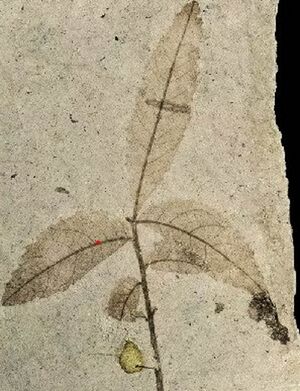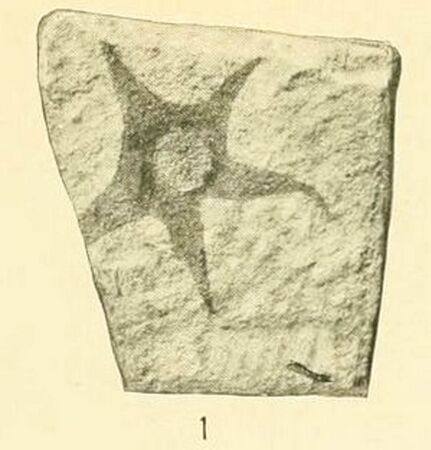Rosa inquirenda Knowlt.
Fossile-Rose, 1916 - beschrieben vom Paläobotaniker/ described by the palaeobotanist/ décrit par le paléobotaniste Frank Hall Knowlton, USA
Eltern/ parentage/ parents: Botanische Rose/ Wild Rose/ Rosier botanique
Vermutliche Synonyme/ Presumed synonyms/ synonymes présumés: Rosa hilliae Lesq., Rosa dubia C.O.Weber
Die Synonyme wurden beschrieben von den Botanikern/ The synonyms were described by the botanists/ Les synonymes ont été décrits par les botanistes Daniel Isaac Axelrod, USA, Shigeru Miki, Japan, Hermann Engelhardt, Deutschland, Charles Arthur Hollick, USA, Ralph Works Chaney, USA, Frank Hall Knowlton, USA, Gábor (Gabriel) Andreánszky, Ungarn, Oswald von Heer, Schweiz, Theodore Dru Alison Cockerell, USA, Hsen Hsu Hu, China, Toshimasa Tanai, Japan, Wladyslaw Szafer, Polen
Allgemeines • Preface • Remarques
Der Paläobotaniker Frank Hall Knowlton ist sich nicht sicher, ob es sich bei dieser fossilen Frucht um die Hagebutte einer Rose handelt. Er setzt daher hinter Rosa ein Fragezeichen und nennt sie inquirenda - die zu erforschende. Der Fund stammt aus dem Oligozän[1], ist also 33,9 - 23,03 Mio. Jahre alt.
Palaeobotanist Frank Hall Knowlton is not sure whether this fossilised fruit is the rose hip of a rose. He therefore puts a question mark after Rosa and calls it inquirenda - the one to be researched. The find dates from the Oligocene[1], i.e. 33.9 - 23.03 million years old.
Le paléobotaniste Frank Hall Knowlton n'est pas certain que ce fruit fossile soit l'églantier d'une rose. Il met donc un point d'interrogation derrière Rosa et l'appelle inquirenda - celle qui doit être étudiée. La découverte date de l'Oligocène[1], c'est-à-dire de 33,9 à 23,03 millions d'années.
Originale Beschreibung • Original description • Description originale
Übersetzung:
ROSA? INQUIRENDA, new species.
Plate 17, fig. 1.
Sie besteht aus einem dicken, kreisförmigen, kapselartigen Körper mit einem Durchmesser von etwa 7 mm und fünf schlanken, spitz auslaufenden Kelchlappen. Die größte Ausdehnung der Lappen beträgt 3 cm, die Länge der einzelnen Lappen 12 oder 13 mm.
Art.-Kat. Nr. 34.741, U.S.N.M. Sammlung Hambach.
Die genaue Art dieses Exemplars ist nicht bekannt, da es nicht deutlich erhalten ist, aber es sieht aus wie eine Hagebutte; es könnte sich jedoch um einen regelmäßig gelappten und etwas koriazösen Kelch einer anderen Gattung handeln.
Original:
ROSA? INQUIRENDA, new species.
Plate 17, fig. 1.
Represented by what appears to be a fruit or "hip," consisting of a thick, circular, capsule-like body about 7 mm. in diameter, and five slender, acute radiating calyx lobes. The greatest spread of the lobes is fully 3 cm., the individual lengths of the lobes being 12 or 13 mm.
Type.—Cat. No. 34,741, U.S.N.M. Hambach collection.
The exact nature of this specimen is not definitely known as it is not clearly preserved, but it has the appearance of being a rose "hip" ; it may, however, be a regular-lobed and somewhat coriaceous calyx of another genus.
Traduction:
ROSA? INQUIRENDA, new species.
Plate 17, fig. 1.
Représenté par ce qui semble être un fruit ou une "hanche", constitué d'un corps épais, circulaire, ressemblant à une capsule d'environ 7 mm de diamètre, et de cinq lobes de calice minces, aigus et rayonnants. La plus grande distance entre les lobes est de 3 cm, la longueur individuelle des lobes étant de 12 ou 13 mm.
Type - Cat. No. 34,741, U.S.N.M. Hambach collection.
La nature exacte de ce spécimen n'est pas connue avec certitude car il n'est pas clairement conservé, mais il a l'apparence d'un "hanche" de rose ; il peut cependant s'agir d'un calice à lobes réguliers et quelque peu coriace d'un autre genre.
Fundort • Find location • Lieu de découverte
Diese fossile Frucht wurde in den Florissant Fossil Beds[2] in Teller County, Colorado, USA gefunden.
This fossilised fruit was found in the Florissant Fossil Beds[2] in Teller County, Colorado, USA.
Ce fruit fossile a été trouvé dans les Florissant Fossil Beds[2] dans le comté de Teller, Colorado, États-Unis.
- Rosa inquirenda
Zum Vergrößern anklicken • click to enlarge • cliquez pour agrandir
↑ Nach oben • Top • Vers le haut ↑
Einzelnachweis • Footnotes • Notes
Weblinks • External links • Liens externes
Literatur • Literature • Littérature
- F. H. Knowlton, A review of the fosail plants in the United States National Museum from the Florissant lake beds at Florissant, 1916 Seite 273 u. Plate 17, Fig. 1
- Herman F. Becker, The fossil record of the genus Rosa, 1963 Rosa inquirenda


